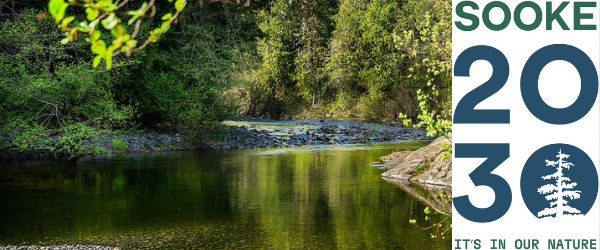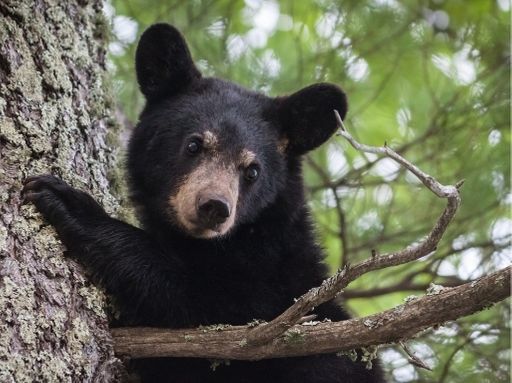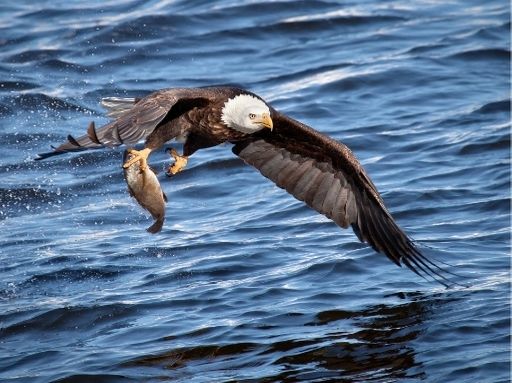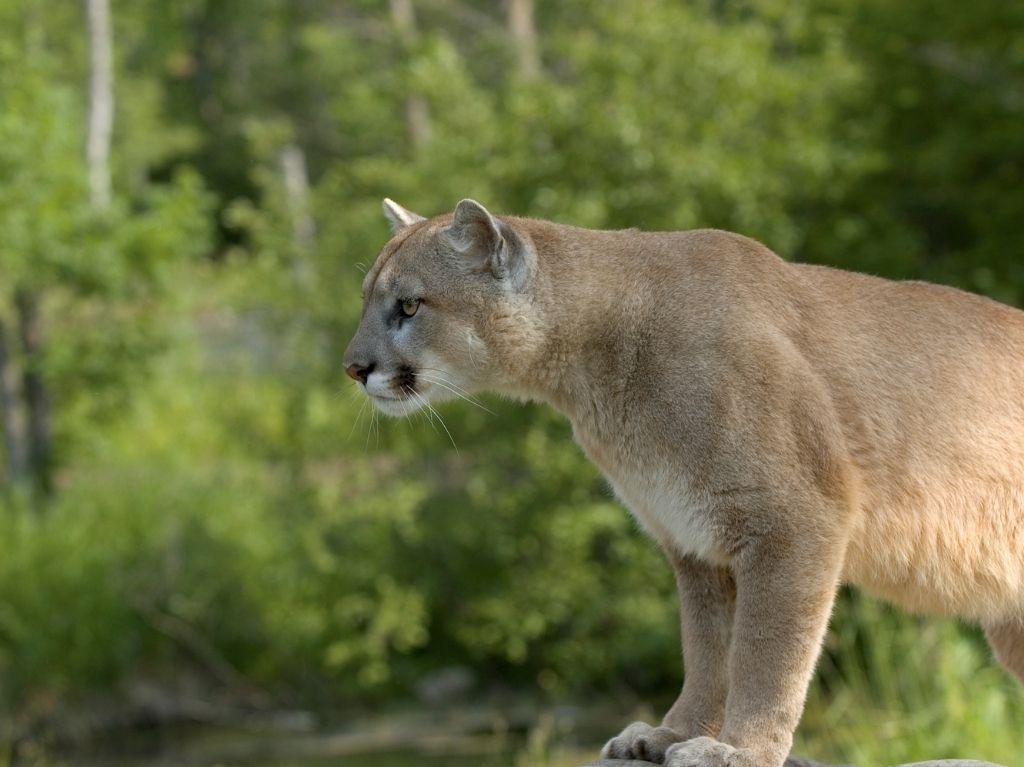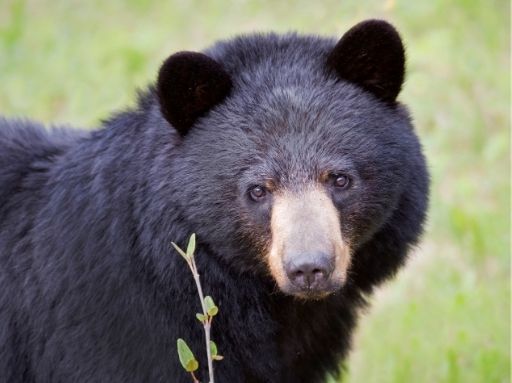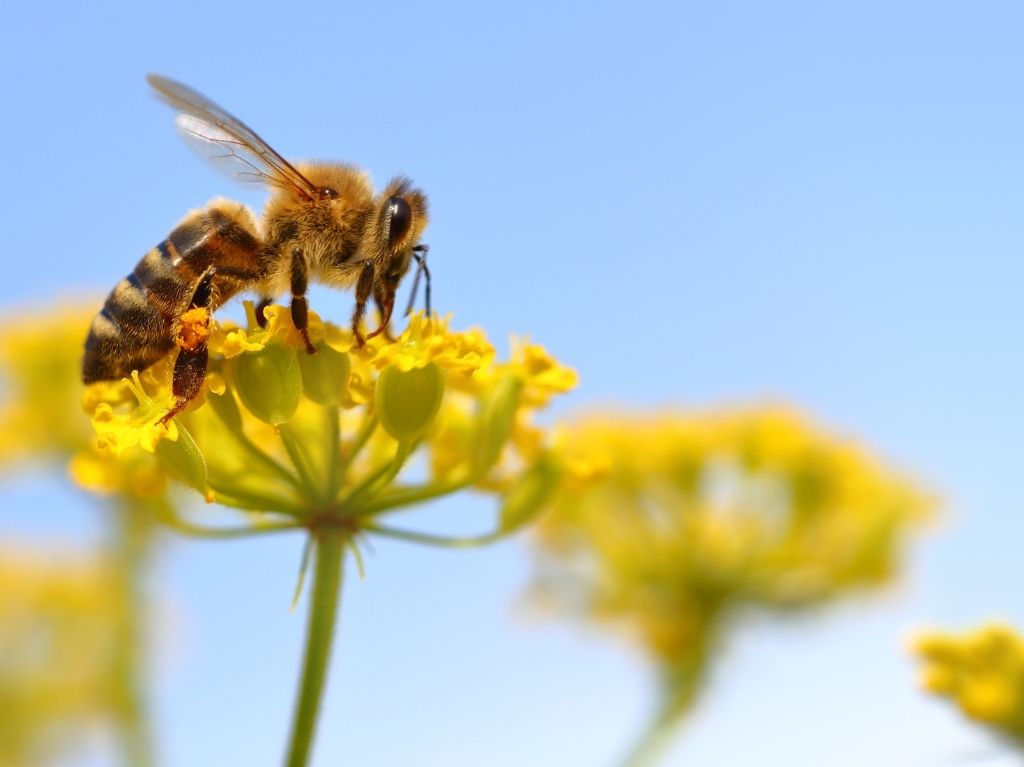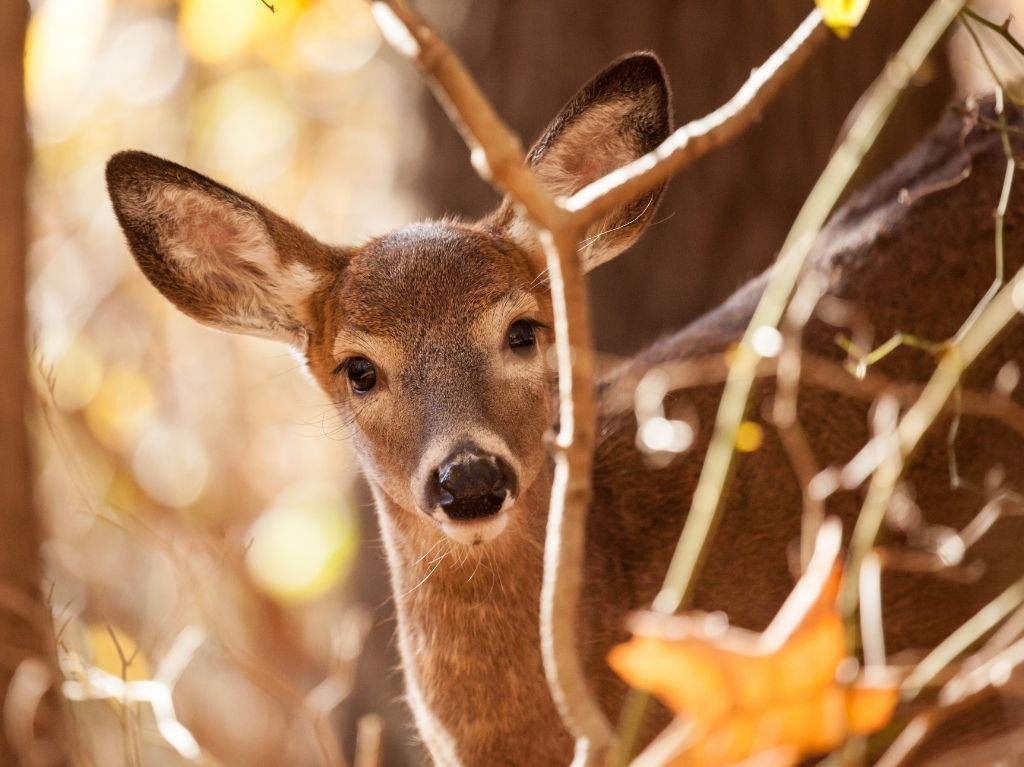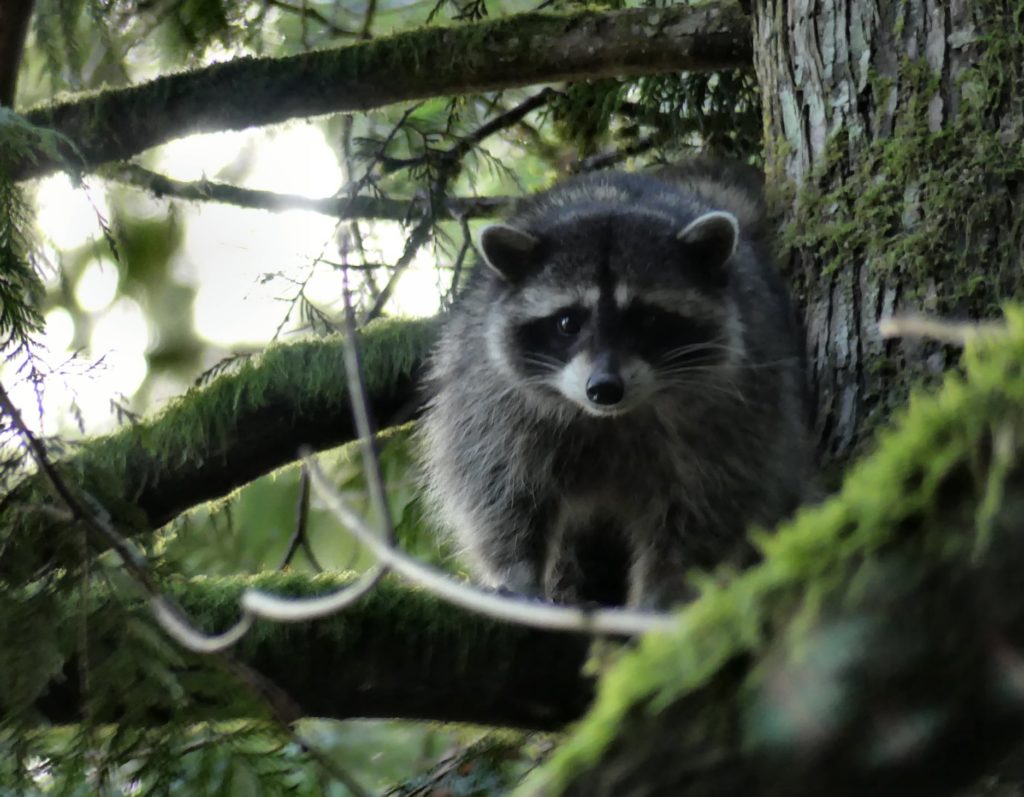Caution Nature
Updated December 12, 2022
Where the rainforest meets the sea, Sooke’s natural surroundings define its character. The Sooke Basin, Sooke Harbour and Sooke River are the defining geographic features, as are the Sooke Hills and surrounding mountainous areas, which provide important natural habitats and opportunities for recreation, trails and economic development. While navigating this balance it is critical residents and visitors are aware of local wildlife for the safety of all. Caution Nature is your resource toolbox on:
- coexisting with wildlife
- species at risk
- responsible pet ownership
DID YOU KNOW: The District works with WildWise Sooke to provide educational programs about feeding and preventing wildlife encounters on residential property? Learn more about Wildwise Sooke by visiting their website or following them on Facebook.
Co-existing with Wildlife
What to know about certain animals:
If you see a bear:
- Remain calm: don’t panic.
- Keep away from the bear and bring children and pets indoors.
- Never approach the bear and do not run from it.
- Warn others of the bear’s presence, without yelling.
- Once the bear has left, check your yard to ensure there are no attractants available.
If the bear is threatening, immediately call the Conservation Officer Service at 1.877.952.RAPP (7277) or local RCMP at 250.642.5241.
How you can help:
Eliminate access to human food
“People teach bears bad habits. If bears are allowed to access human food and garbage, they quickly learn to associate it with people and become what is called food-conditioned. These bears also become habituated to people as they lose their fear of humans.
Habituated and food-conditioned bears learn to expect human food and are more likely to approach people, increasing risks to public safety, and are more difficult to drive away than wild bears” (Bear Smart Community Program).
Secure your attractants
- Secure garbage in the garage or shed until the morning of collection.
- Protect livestock with electric fence and shelter.
- Pick fruit trees and prevent windfall.
- Do not feed wildlife.
- Freeze organic waste to prevent it from smelling.
- Clean BBQ after every use.
- Feed pets indoors.
- Store pet and livestock feed in a bear-resistant location.
Progress:
In 2008, the BC Conservation Officer Service received approximately 240 bear complaints from residents in the District of Sooke. Five bears had to be destroyed as a result of bear/human conflict. This level of interaction establishes Sooke as being a community with one of the highest levels of human/bear conflicts in the province.
As of September 2020, the B.C. Conservation Service has investigated 60 bear complaints in Sooke since April 1, with two animals euthanized. This from the previous year when conservation officers received 202 complaints.
Additional resources:
For more information about being BEAR AWARE check out wildsafebc.com.
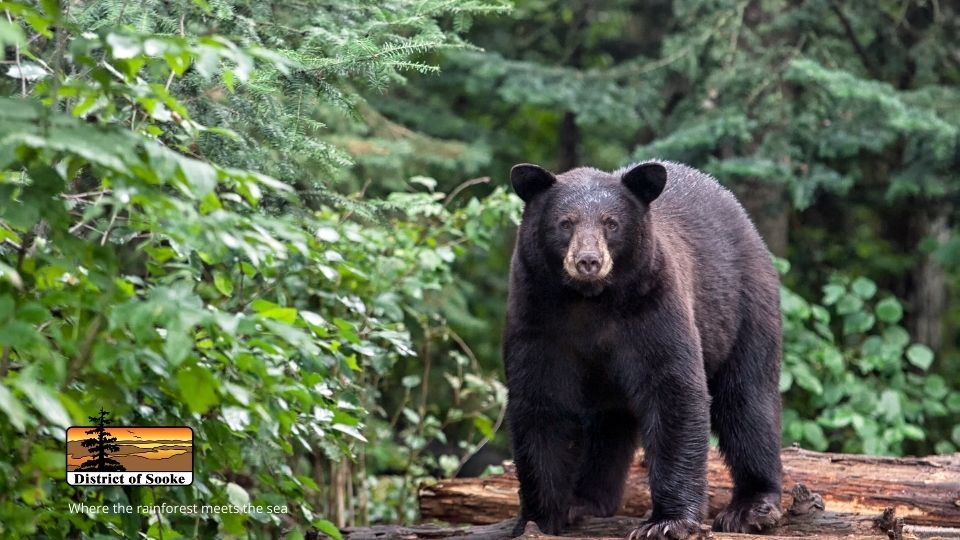
Many cities and towns, like Sooke, have many natural areas that support black-tailed deer. Urban deer populations benefit from abundant food and shelter. They have lesser natural predators and bylaws prohibit hunting them within city limits. As a result, urban deer populations have tremendous growth potential.
Deer sometimes damage gardens, shrubs, fruit trees and other public or private property. They can be a threat to human health and safety when they wander onto roadways and collide with vehicles. They can also carry deer ticks, which may transmit Lyme disease to humans.
The challenge is to find an acceptable balance between the number of deer in the District and the associated risk to people and their property.
How you can help:
Do Not Feed the Deer
It is extremely important that people do not feed deer. Deer can find natural food sources and survive well on their own. In fact, handouts from humans may do the deer more harm than good:
- Feeding deer, especially during winter, maintains artificially high populations that make deer more susceptible to starvation and disease.
- Deer become accustomed to food handouts and lose their fear of humans, putting both deer and people at greater risk.
- Feeding deer attracts more of them to an area resulting in more damage to nearby properties.
- Feeding encourages deer to travel, increasing risks when they cross streets.
The BC Conservation Officer Service (http://www.env.gov.bc.ca/cos/) has authority under British Columbia Wildlife Act to order people to stop feeding deer if it creates a risk of property damage or a risk to health and safety for wildlife or people.
Additional resources:
To find out more about what you can do to minimize or reduce the damage caused by deer to your property, please visit the Ministry of Environment’s website.

“Of the estimated 4000 cougars in Canada, 3500 live in BC. Of this, nearly a quarter reside on Vancouver Island (itself only representing 3% of BC’s land area), resulting in the highest concentration of cougars in the world. Living mainly in the forested mountain habitats of the Island, the continual expansion of humans into their territory forces these shy creatures to interact with humans. Cougar attacks, though rare, have helped these animals to become feared and misunderstood” (Vancouver Island Wilderness and Historial Conservation).
If you see a cougar:
- Make yourself look as large as possible and keep the cougar in front of you at all times
- Never run or turn your back on a cougar, sudden movement may provoke an attack
- If a cougar shows interest or follows you, respond aggressively, maintain eye contact with the cougar, show your teeth and make a loud noise. Arm yourself with rocks or sticks as weapons
If the cougar is threatening, immediately call the Conservation Officer Service at 1.877.952.RAPP (7277) or local RCMP at 250.642.5241.
Why are cougars important to Vancouver Island:
As a top predator, similar to the wolves, the cougar is an important control for lower trophic levels, starting with the deer. As well, given that Vancouver Island is such a stronghold for this species in BC, the protection of the population on the island could serve as an important founding colony if local extirpations occur in other areas of Canada or the Northwest.
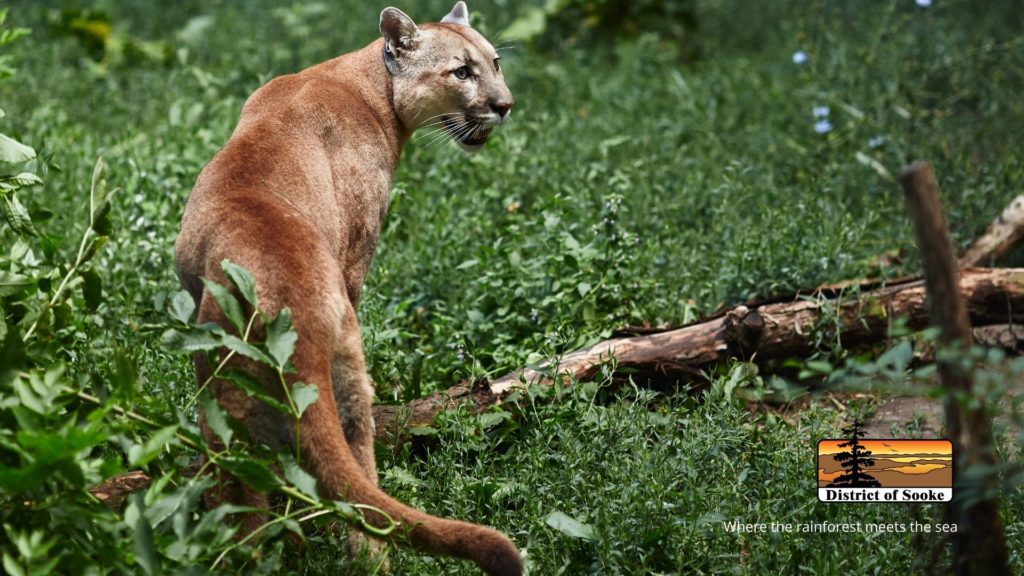
If you see a honeybee swarm:
- Don’t panic.
- Call a local beekeeper. In Sooke, you can contact the Swarm Phone Tree at 250-900-5787.
The Swarm Committee member will do their best to find someone who will attempt to remove the bees for you, for free. Note: that they will only remove honeybees and only if it can be safely done. You may still need to call an exterminator if the bees turn out to be wasps or some other bee-like creatures.
What else do I need to know about honeybee swarms:
Are you sure it is a swarm? A swarm will move as a big cloud of thousands of bees, buzzing very noisily. They will settle on something (usually a tree, but it could be anything, even open ground). When they do, they will form a solid mass of bees about the size of a football and sometimes much larger.
What is a swarm? A swarm is a group of settler bees, heading out to find a new home. They are a natural part of how bees have survived for millions of years. There will be a queen at the centre and thousands of female workers around her. In addition, hundreds of other bees will be acting as scouts. They fly out to find a suitable cavity to build the new hive in and report back.
Is a swarm dangerous? Can I get stung? Not usually, but yes possibly. A swarm is much more interested in finding a new home than in stinging you. And normally the bees are gorged on honey and quite calm. But they get testy if they have been out in the open for a few days. So it’s better not to get too close.
Additional resources:
Learn more about swarming from the Ministry of Agriculture.
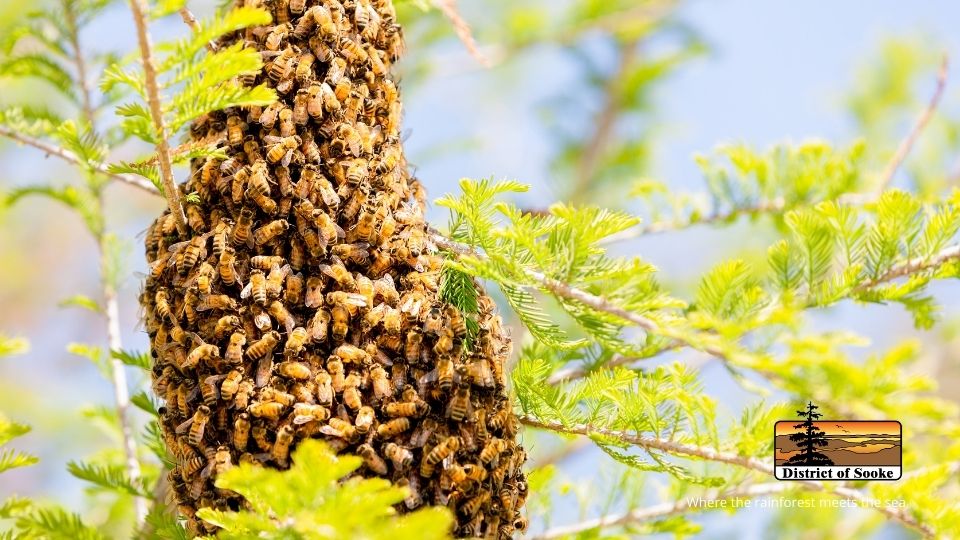
What to know about the “catastrophic moult”
In the spring and summer months, moulting pinnipeds may make their way to shore, please keep your distance. If you spot a sickly looking elephant seal on land, it is probably moulting. All elephant seals spend one month a year on land to moult; they undergo what is called a “catastrophic moult” in which they shed all of their fur along with the underlying layer of skin. For just over a month, the seal is confined to land and spends most of its time dozing and lazily flipping sand onto itself to stay cool. It doesn’t eat and may lose up to 25% of its body weight.
The seal may look slow and harmless, but is capable of moving very quickly and could be dangerous if it feels threatened. If you see an animal being harassed or injured or an injured or sick animal exhibiting highly unusual behaviour, please call DFO’s Observe, Record and Report 24-hour hotline at 1-800-465-4336.
Seal Pups
Seal pupping season occurs during spring and summer, a peak time for boaters and beach goers. Each year people find baby seals, commonly known as seal pups, on shore and pick them up thinking they have been abandoned. The mothers may simply be out foraging,or frightened away by human presence and will shortly return to reclaim and tend to their pup.
Should you encounter a lone seal pup please keep your distance and do not attempt to remove the seal as it may not need rescuing and your actions can endanger its life.
How you can help a seal pup:
| DO NOT: | DO: |
|
|
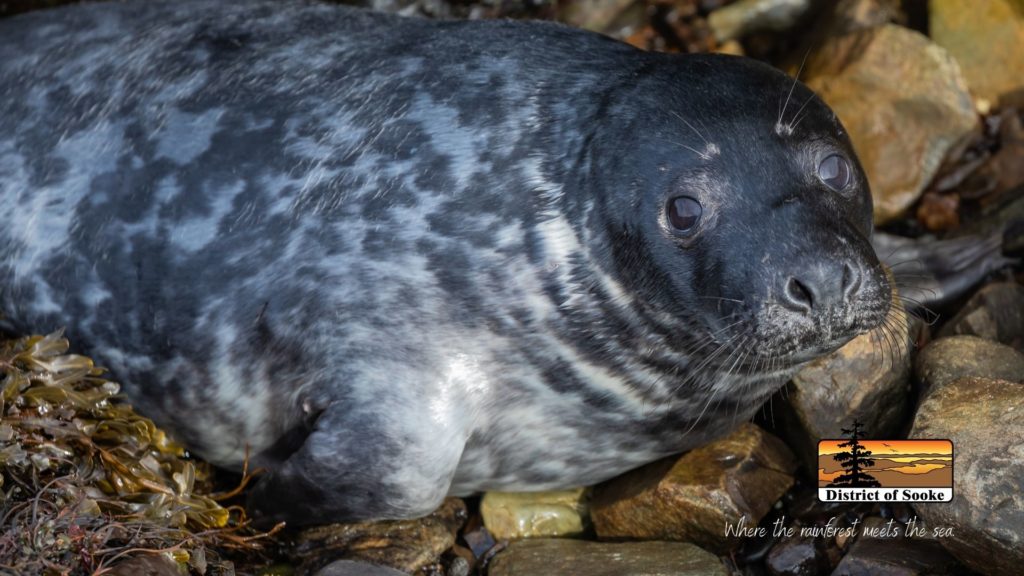
Resource Materials
- Do you have wildlife activity in your neighbourhood? Could your street benefit from a signs or flyers? Help reduce human-wildlife conflicts by contacting WildWise Sooke at wildwise123[at]gmail.com.
Invasive Species
Invasive species are plants and animals not native to British Columbia and the Sooke region. Although their spread can have beneficial aspects, invasive species adversely affect the invaded habitats, causing ecological, environmental, and/or economic damage. They can spread rapidly, outcompete native species, and dominate natural and managed areas.
- Learn more about the management of invasive species through the Government of British Columbia’s web page on Invasive Species, and check back here for local implications in Sooke.
- Reporting invasive species to the Province of British Columbia
Poison hemlock is a priority invasive species of concern with serious human and animal health risks from ingestion or skin contact.
Why is poison hemlock a problem?
- Public health hazard: Eating even a small amount of any part of this plant can kill people or animals. Dead plants remain toxic for up to three years. This plant is also toxic to the skin and respiratory system. If any portion of the plant is ingested, seek medical attention immediately
- Introduced species that establishes and spreads quickly, with a preference for a disturbed site
- Out-competes native vegetation through aggressive growth and prolific seed production
What does it look like?
- Tall, extensively branching plant 0.5-3m tall with distinctive purple blotched, thick, hollow, hairless stems
- Bright green, fern-like triangular leaves are finely divided, with a strong musty odour
- Tiny, white, 5-petaled flowers form a broad umbrella-shape (up to 0.5m across), on the ends of branches
- Note: Poison hemlock can be mistaken for edible plants in the same family (e.g. parsley or carrot).
What should you do if you spot a poison hemlock plant?
- Spread the word, not the weed: Don’t buy, grow or trade this plant. Using protective methods, clean off footwear, pets, equipment and vehicles before leaving areas where this species is present
- Inform: report outbreaks to parks@sooke.ca with the location and photo for support and monitoring
- Remove: if you have an outbreak on your property, please follow these instructions for removal (for small infestations (less than 25-30 plants):
- Caution: Use gloves, safety glasses and protective clothing when handling, avoid any skin contact or inhaling scent. Wash all clothing and tools afterwards
- Manual removal: before flowering, dig or pull to avoid soil disturbance; prevent flowering and seed production
- Cut: if unable to remove the entire root, cut the plant/root about 3cm below ground
- Bag flowers/seeds: if in flower or seed, carefully remove and bag flowers/seed heads before digging
- Clean before leaving: to avoid skins burns and further spread, wash/brush off footwear, vehicles and equipment before leaving site
- Monitor: return in spring and fall for a few years to monitor growth and remove new plants
- Replant: especially in disturbed areas, replant with non-invasive or native plants
- Dispose: of all plant parts in the proper manner
- Proper disposal: Please place all plant part in garbage bags labelled “invasive species” and take to Hartland Landfill. Do not compost. Flowers can still form viable seeds after removal.
- Soil and gravel: use only soil and gravel that are not contaminated with seeds and only remove soil from infested sites with a safe disposal/treatment plan in place to avoid further spread
Source: Capital Regional Invasive Species Program Invasive Species Alert Sheet on Poison Hemlock.
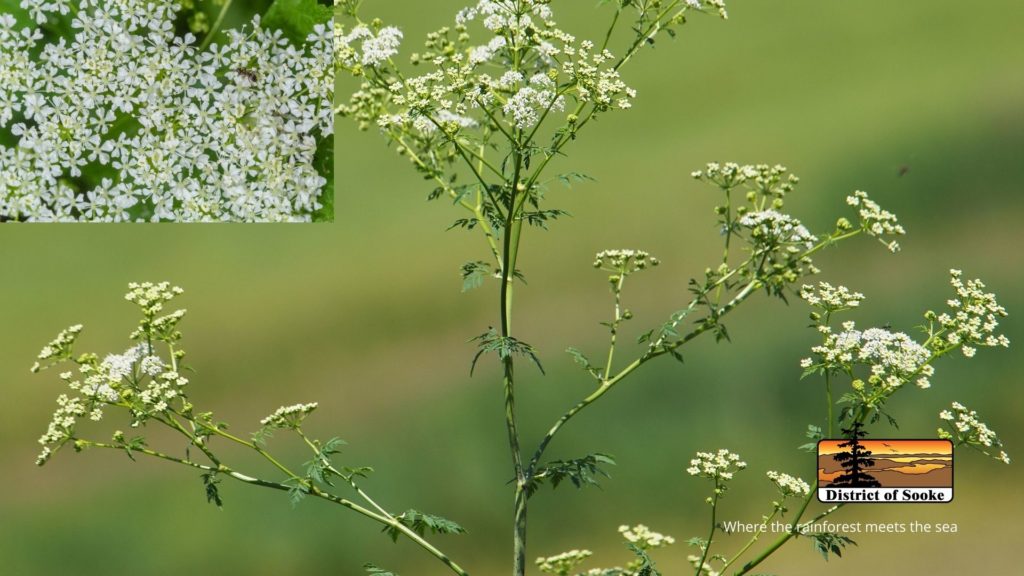
Giant hogweed is a priority invasive of concern with serious human health risks.
Why is giant hogweed a problem?
- Public health hazard: risk of severe burns, scarring and temporary or permanent blindness in humans
- Watery sap in the stalk, stem and leaves is highly toxic, causing dermatitis after contact with sunlight (effects within hours or days and scarring can last from months to a lifetime)
- See WorkSafe BC alert for first aid treatment at www.worksafebc.com
- Outcompetes native plants and causes soil erosion on steep slopes and stream banks
What does it look like?
- Large plant up to six metres tall with deeply lobed leaves and umbrella-shaped white flower heads up to one metre across
- Giant Hogweed is often confused with native Cow Parsnip. The notable difference between the plants is size: giant hogweed is much taller (4 to 5 m), at maturity, than cow parsnip (2 to 3 m). See this resource page from the Groupe de Recherche Queberce which helps differentiate between the two species.
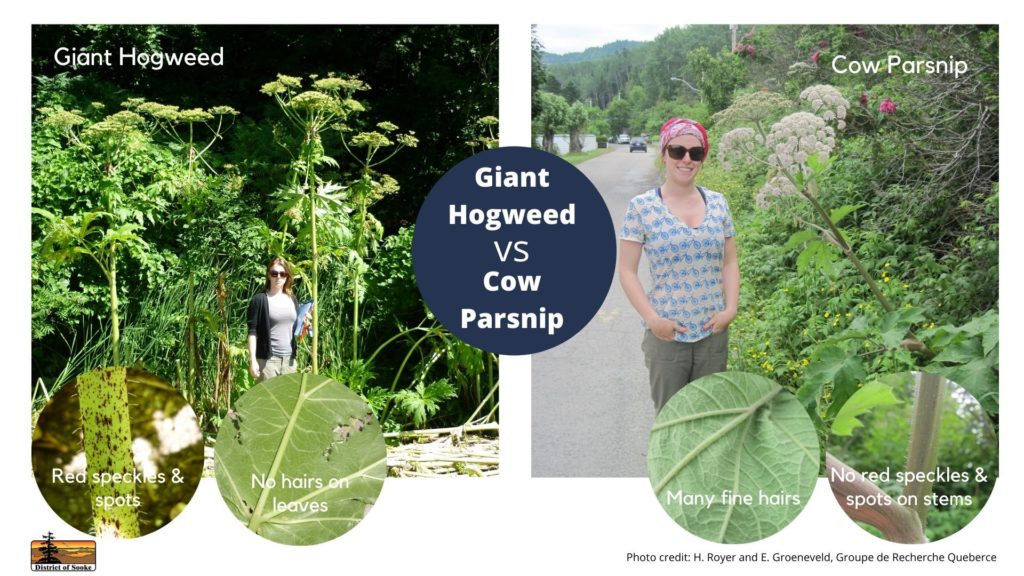
What should you do if you spot a giant hogweed plant?
Please report any sightings of this invasive species to the contacts listed below.
- Spread the word, not the weed: don’t purchase, grow or trade giant hogweed
- Inform: please report outbreaks to parks@sooke.ca with the location and photo for support and monitoring
- Remove: if you have an outbreak on your property, please follow the instructions below for careful removal and follow up (for small infestations (less than 25-30 plants):
- Manual removal: remove young plants by gently hand pulling to remove all roots
- A small hand tool can be used to ease out the roots
- For large, mature plants cut the stem near the base, then dig out the roots (focus on central root and remove at least 8—12 cm below soil surface)
- For all manual removal, care should be taken to minimize soil disturbance which can encourage seeds to germinate
- Ideally, remove in spring and repeat as required in early summer
- If removing late during flowering season cut, bag and dispose of flower-heads first
- Mulch over the area disturbed by the removal may be beneficial
- Dispose: of all plant parts in the proper manner
- Proper disposal: Please place all plant part in garbage bags labelled “invasive species” and take to Hartland Landfill. Do not compost. Flowers can still form viable seeds after removal.
- Soil and gravel: use soil and gravel that are not contaminated and only remove soil from infested sites with safe disposal/treatment plan to avoid further spread
- Prevent spread: brush off clothing, tires, equipment before leaving an infested area
- Monitor: for several years, return to the site in spring and summer to continue treatment
- Replant: after effectively eliminating this species over time, replant with non-invasive plants (such as appropriate native species)
Source: Capital Regional Invasive Species Program Invasive Species Alert Sheet on Giant Hogweed.
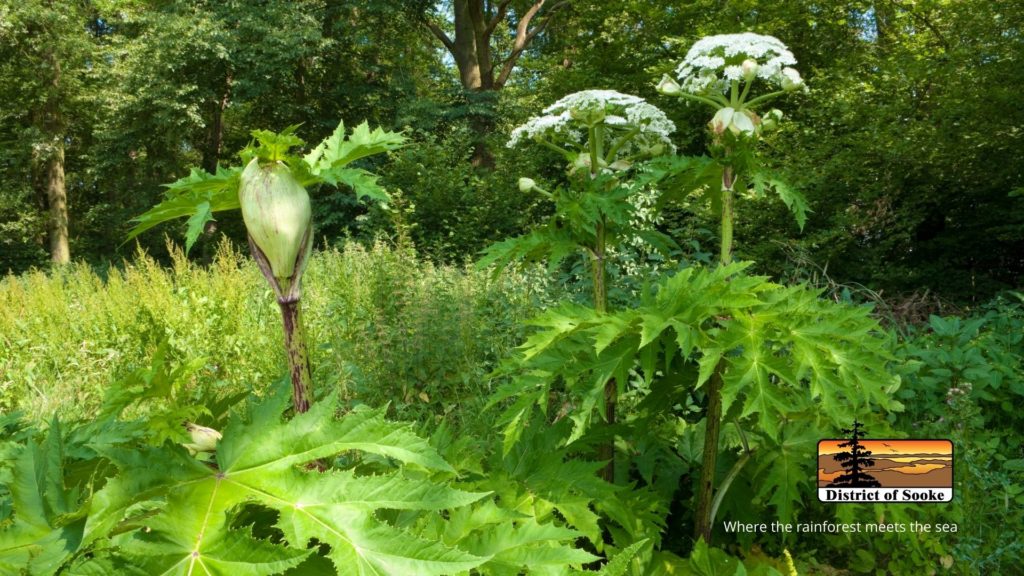
Himalayan balsam, commonly known as policeman’s helmet, is an invasive alien species threatening wetlands throughout much of the northern hemisphere. While native to the Himalayas, this plant spreads aggressively along riverbanks. The main threat posed by this plant is against native vegetation. On many occasions, native plants are out-competed and often suffocated.
What does it look like?
The name “policeman’s helmet” comes from the flowers, which are shaped like a British policeman’s helmet. The stem of this plant is usually purple with a reddish tinge. It is hollow and heavily branched. The leaves are egg-shaped with a serrated edge.
What does it threaten?
This plant spreads aggressively along riverbanks and may replace native perennials, possibly resulting in erosion. Significant nectar stores may draw native pollinators away from native flowers. Dense stands may exclude native plants and wildlife.
How can you help?
Everyone can help to win the battle against alien invasive species. Here are some ways you can help:
- Dispose of yard waste properly. Dumping yard waste in natural areas can introduce alien invasive species that will thrive and spread. Even leaf piles can be problematic, as dumped piles can smother native vegetation. Contact your municipality to find out how to dispose of yard waste properly.
- Plant native species in your garden. There are lots of beautiful native species that attract native butterflies and birds, making your garden twice as beautiful. Native species are also adapted to our climate and often require less rigorous care than exotic species.
- Clean your shoes or bicycle tires when moving between designated trails in different areas. Invasive plants are often spread accidentally from seeds stuck in treads.
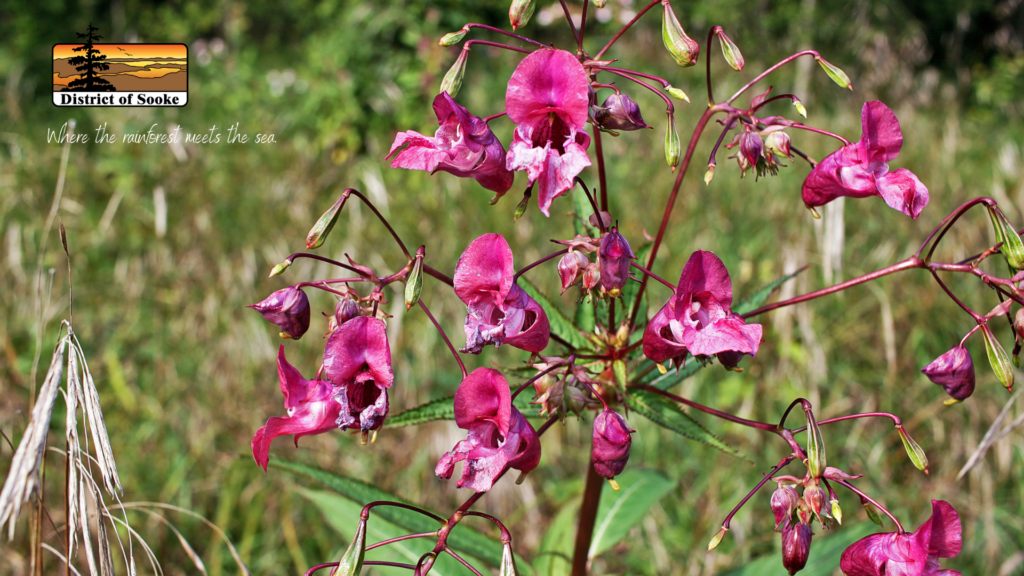
The European green crab (EGC) is a small coastal crab that has had major negative impacts on the marine environment. It is an invasive species that has been spreading over the last couple of decades and is considered one of the 10 most unwanted species in the world. It has few predators, aggressively hunts and eats its prey, destroys seagrass, and outcompetes local species for food and habitat.
EGC has been spreading along the west coast of North America for the last 30 years, and has been detected in BC on the west coast of Vancouver Island and parts of the Central Coast since 2006. EGC was detected in the Strait of Georgia for the first time in 2019.
The time animated map shows positive detections of EGC in BC made by the Department of Fisheries and Oceans Canada (DFO) from 2006 to 2021.
EGC can alter BC shoreline ecosystems and negatively impact economically and culturally important species and habitats, including eelgrass beds that provide critical food and cover for juvenile salmon and forage fish.
Report sightings:
To report European green crab sightings, except along west Vancouver Island, call 1-888-356-7525 or email AISPACIFIC@dfo-mpo.gc.ca in the Pacific region. Those reporting should submit a photograph, an exact location and date of sighting, and note identifying features.
Resources:
- Soft-shell Green Crabs 101 Webinar (June 30, 2020)
- Visit anecdata.org to learn about our community/citizen science effort
- Find out more in our four-page identification and collection guide
- If you find a crab, please report your finding in our online data collection form
- Watch our FaceBook Live Video
- View green crab recipes and culinary guides
Media & Press:
- “Harm to Table: Turning an Invasive Crab into a Delicacy” (Scientific American, October 30, 2019)
- “If you can’t beat ’em – eat ’em” (“WCVB, May 20, 2019)
- “Scientists ask for public’s help to count green crabs on the Seacoast” (New Hampshire Union Leader, May 14, 2019)
- “The Great Green Crab Hunt… and hunt for a new fishery” (NEOSEC News, March 9, 2019)
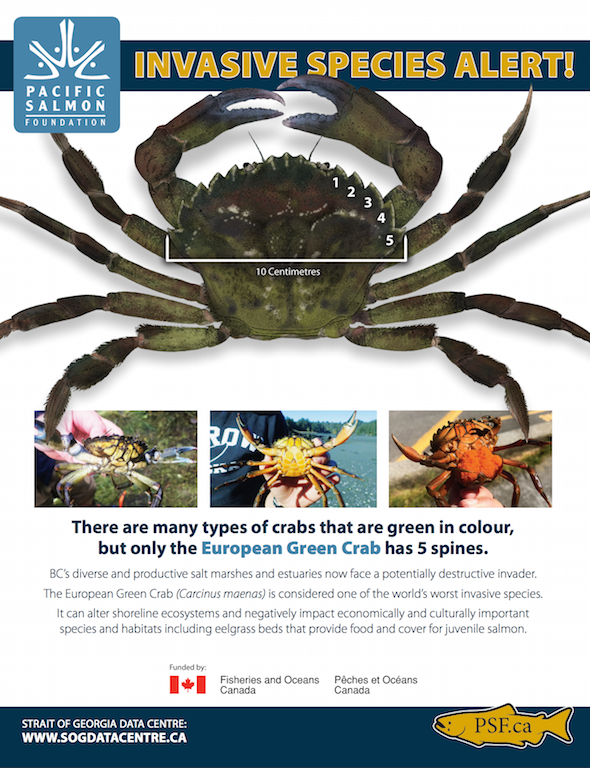
Species at Risk
Learn more about these species of significance:
The District of Sooke is home to the streambank lupine, which is listed as endangered by the Committee on the Status of Endangered Wildlife in Canada (COSEWIC). It is found along the banks of the Sooke River and within the Sooke Potholes Provincial Park.
View the Proposed Recovery Strategy for the Streambank Lupine (Lupinus rivularis) in Canada.
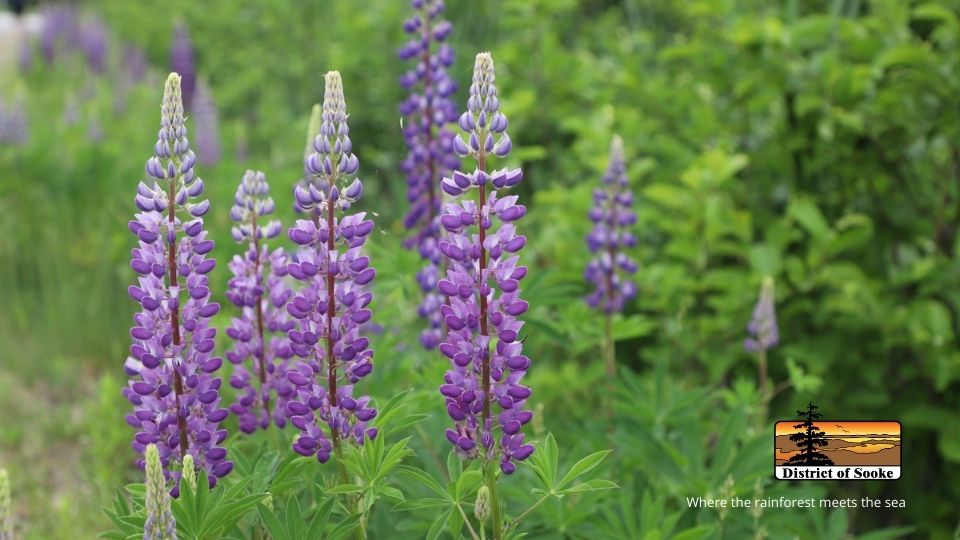
The District of Sooke is home to the Blue-grey taildropper slug, which is listed as endangered by the Committee on the Status of Endangered Wildlife in Canada (COSEWIC). It is found along the banks of the Sooke River and is known to occur adjacent to the Galloping Goose Regional Trail along Sooke River Road. The critical habitat (older forests with a deciduous component) of this species is threatened by habitat loss from recreational use and habitat loss from urban development.
Learn more about the Blue grey Taildropper Slug through Habitant Acquisition Trust.
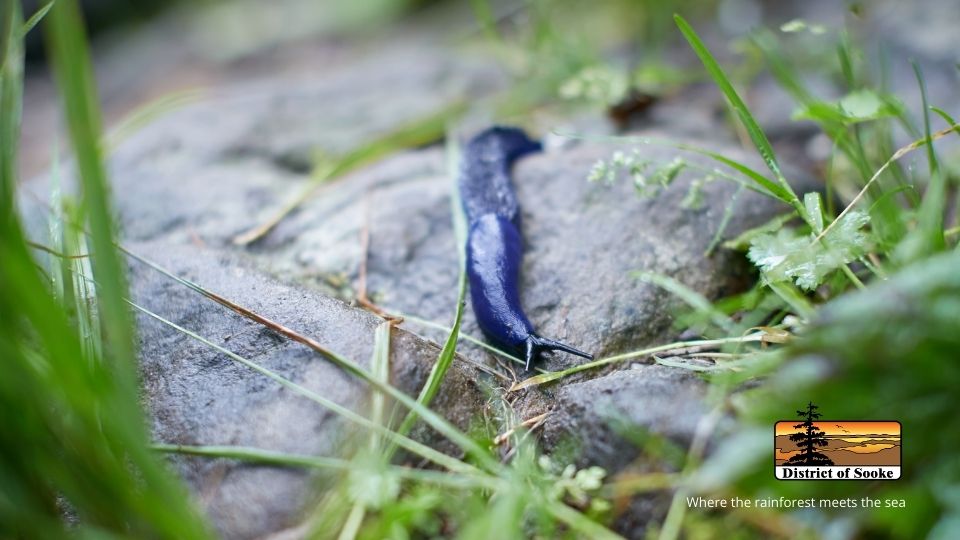
The entire District is considered habitat to the ermine (Auguinae subspecies). The ermine is blue-listed 1 by the BC Conservation Data Centre (BC CDC) and appears to prefer low elevation sites near the ocean, rivers, creeks and estuaries. They can be seen occasionally on Whiffin Spit.
Learn more about the ermine and the Government of Canada’s ermine recovery strategy.
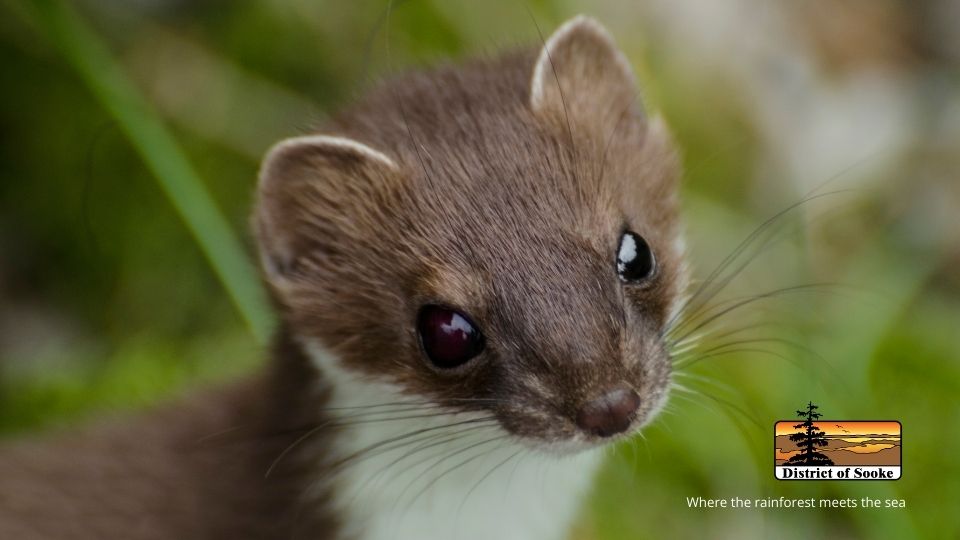
The entire District is a potential habitat to the Keen’s myotis (a bat). The Keen’s myotis is red-listed by the BC CDC and is believed to nest in tree cavities, rock crevices and small caves, and hunt along forest edges and openings as well as over ponds.
Learn more about the Keen’s myotis in this British Columbia’s Wildlife at Risk information sheet.

The District of Sooke has the only known occurrence of the Nevada marsh fern in Canada and is red-listed by the BC CDC. An additional four blue-listed plant species occur within the District.
- Pacific waterleaf is widely dispersed in the moist woodlands and stream banks.
- Common bluecup can be found in moist seepages around the Sooke River.
- Fleshy jaumea is found in moist tidal beaches and salt marshes in the lowland zone.
- Macoun’s groundsel is found in the dry open forests, disturbed areas and rock outcrops of the District.
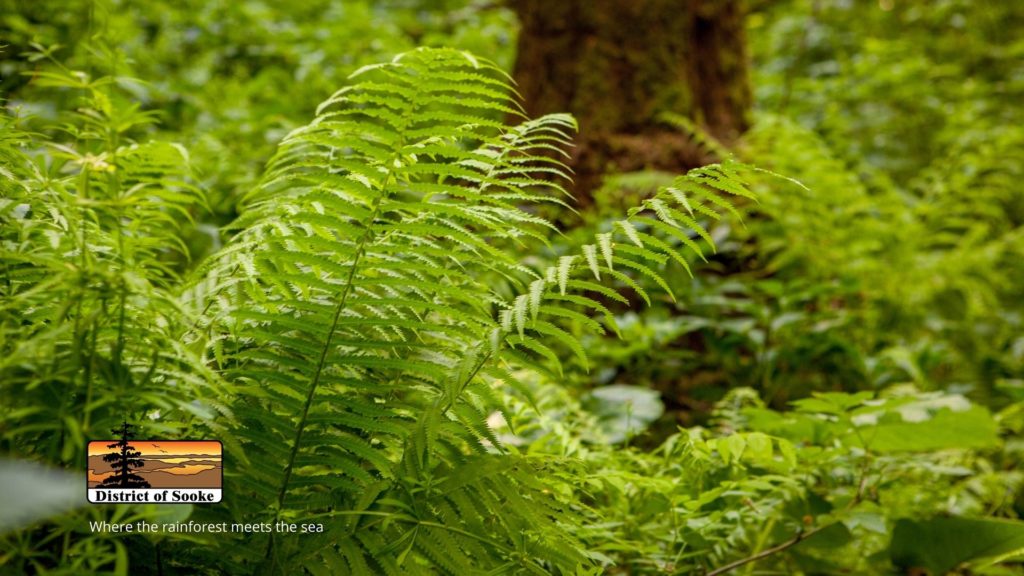
Great blue herons, listed as Special Concern by COSEWIC, are also known to use habitat within the District of Sooke. No up-to-date information is available on nesting and roosting sites for the area. Human activity near heron colonies poses the largest threat to this subspecies (COSEWIC 2008).
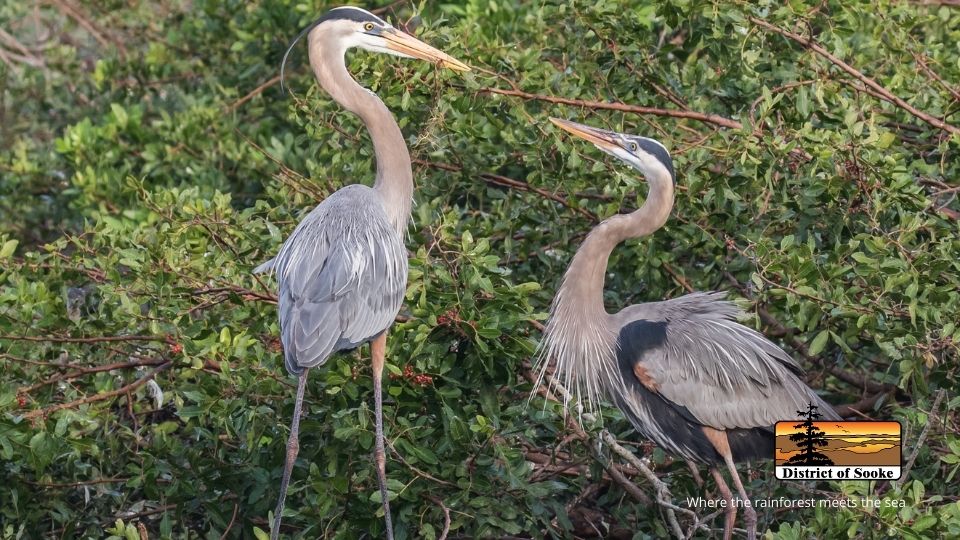
In 2005, bald eagles nested at three locations (two additional inactive nests) within the District. Four chicks fledged from these nests. Habitat loss and degradation as well as shooting the animal for their feathers are considered key threats to this species. This species is not listed by the BC CDC or by COSEWIC.

Responsible Pet Ownership
“Free-roaming pets are at risk of predation when not secured on a leash, in a catio or in your home. Animals like eagles, wolves, cougars and bears may flock to an area with an abundance of free-roaming pets. This can of course be very dangerous for your pet AND for nearby livestock and community members.
Predators who are lured in by pets often pay the price with their life. It is easy to prevent loss of life by keeping your pets safely secured. Unsecured pets are a leading cause of death to birds and small mammals. Unfortunately adding bells to their collars is not a sufficient warning method as animals do not associate the sound of bells with a predatory threat. It’s a dangerous world out there for your pet. Fights with other cats or raccoons can be brutal and lead to injuries, infection, loss of limb/eyes/tail not to mention pain and suffering. You can help keep everyone safe by keeping your pets secured. Catios are the safest option for outdoor-loving cats, local wildlife and our community as a whole” (Wildwise Facebook page)
Additional resources:
